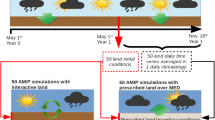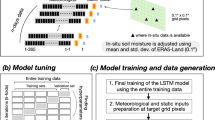Abstract
Soil moisture exhibits outstanding memory characteristics and plays a key role within the climate system. Especially through its impacts on the evapotranspiration of soils and plants, it may influence the land energy balance and therefore surface temperature. These attributes make soil moisture an important variable in the context of weather and climate forecasting. In this study we investigate the value of (initial) soil moisture information for sub-seasonal temperature forecasts. For this purpose we employ a simple water balance model to infer soil moisture from streamflow observations in 400 catchments across Europe. Running this model with forecasted atmospheric forcing, we derive soil moisture forecasts, which we then translate into temperature forecasts using simple linear relationships. The resulting temperature forecasts show skill beyond climatology up to 2 weeks in most of the considered catchments. Even if forecasting skills are rather small at longer lead times with significant skill only in some catchments at lead times of 3 and 4 weeks, this soil moisture-based approach shows local improvements compared to the monthly European Centre for Medium Range Weather Forecasting (ECMWF) temperature forecasts at these lead times. For both products (soil moisture-only forecast and ECMWF forecast), we find comparable or better forecast performance in the case of extreme events, especially at long lead times. Even though a product based on soil moisture information alone is not of practical relevance, our results indicate that soil moisture (memory) is a potentially valuable contributor to temperature forecast skill. Investigating the underlying soil moisture of the ECMWF forecasts we find good agreement with the simple model forecasts, especially at longer lead times. Analyzing the drivers of the temperature forecast skills we find that they are mainly controlled by the strengths of (1) the soil moisture-temperature coupling and (2) the soil moisture memory. We find a negative relationship between these controls that weakens the forecast skills, nevertheless there is a middle ground between both controls in several catchments, as shown by our results.











Similar content being viewed by others
References
Balsamo G, Viterbo P, Beljaars A, van den Hurk B, Hirschi M, Betts AK, Scipal K (2009) A revised hydrology for the ECMWF model: verification from field site to terrestrial water storage and impact in the integrated forecast system. J Hydrometeorol 10(3):623–643
Balsamo G, Boussetta S, Dutra E, Beljaars A, Viterbo P, den Hurk BV (2011) Evolution of land surface processes in the IFS. ECMWF Newsl 127:17–22
Balsamo G et al (2012) ERA-interim/land: a global land-surface reanalysis based on ERA-Interim meteorological forcing. In: Technical report ECMWF, ERA, report series vol 13, pp 349–362
Buizza R, Palmer TN (1998) Impact of ensemble size on ensemble prediction. Mon Weather Rev 126:2503–2518
Delworth TL, Manabe S (1988) The influence of potential evaporation on the variabilities of simulated soil wetness and climate. J Clim 1:523–547
Douville H (2010) Relative contribution of soil moisture and snow mass to seasonal climate predictability: a pilot study. Clim Dyn 34:797–818
Dqu M (1997) Ensemble size for numerical seasonal forecasts. Tellus A 49:74–86
Entin JK, Robock A, Vinnikov KY, Hollinger SE, Liu S, Namkhai A (2000) Temporal and spatial scales of observed soil moisture variations in the extratropics. J Geophys Res 105:11,865–11,877
Ferro CAT, Richardson DS, Weigel AP (2008) On the effect of ensemble size on the discrete and continuous ranked probability scores. Met Apps 15:19–24
Hersbach H (2000) Decomposition of the continuous ranked probability score for ensemble prediction systems. Weather Forecast 15:559–570
Hirschi M, Seneviratne SI, Alexandrov V, Boberg F, Boroneant C, Christensen OB, Formayer H, Orlowsky B, Stepanek P (2011) Observational evidence for soil-moisture impact on hot extremes in southeastern Europe. Nat Geosci 4:17–21
Kirchner J (2009) Catchments as simple dynamical systems: catchment characterization, rainfall-runoff modeling, and doing hydrology backward. Water Resour Res 45:W02–429
Koster RD, Mahanama S (2012) Land surface controls on hydroclimatic means and variability. J Hydrometeorol 13:1604–1620
Koster RD, Milly PCD (1997) The interplay between transpiration and runoff formulations in land surface schemes used with atmospheric models. J Clim 10:1578–1591
Koster RD, Suarez MJ (2001) Soil moisture memory in climate models. J Hydrometeorol 2:558–570
Koster RD, Suarez MJ, Liu P, Jambor U, Berg A, Kistler M, Reichle R, Rodell M, Famiglietti J (2004a) Realistic initialization of land surface states: impacts on subseasonal forecast skill. J Hydrometeorol 5:1049–1063
Koster RD et al (2004b) Regions of strong coupling between soil moisture and precipitation. Science 305:1138–1140
Koster RD et al (2010) Contribution of land surface initialization to subseasonal forecast skill: first results from a multi-model experiment. Geophys Res Lett 37:L02402
Koster RD et al (2011) The Second Phase of the Global Land-Atmosphere Coupling Experiment: Soil Moisture Contributions to Subseasonal Forecast Skill. J Hydrometeorol 12:805–822
Mueller B, Seneviratne SI (2012) Hot days induced by precipitation deficits at the global scale. In: Proceedings of the national academy of sciences, 109 (31), 12,398–12,403
Orth R, Seneviratne SI (2012) Analysis of soil moisture memory from observations in Europe. J Geophys Res 117(D15):115. doi:10.1029/2011JD017366
Orth R, Seneviratne SI (2013a) Propagation of soil moisture memory to streamflow and evapotranspiration. Hydrol Earth Syst Sci 17:3895–3911. doi:10.5194/hess-17-3895-2013
Orth R, Seneviratne SI (2013b) Predictability of soil moisture and streamflow on sub-seasonal timescales: a case study. J Geophys Res 118(19):10,963–10,979. doi:10.1002/jgrd.50846
Orth R, Koster RD, Seneviratne SI (2013) Inferring soil moisture memory from streamflow observations. J Hydrometeorol 14:1773–1790
Quesada B, Vautard R, Yiou P, Hirschi M, Seneviratne SI (2012) Asymmetric European summer heat predictability from wet and dry southern winters and springs. Nat Clim Change 2:736–741
Seneviratne SI, Koster RD (2012) A revised framework for analyzing soil moisture memory in climate data: derivation and interpretation. J Hydrometeorol 13:404–412
Seneviratne SI, Corti T, Davin EL, Hirschi M, Jaeger EB, Lehner I, Orlowsky B, Teuling AJ (2010) Investigating soil moisture-climate interactions in a changing climate: a review. Earth Sci Rev 99:125–161
Seneviratne SI et al (2006) Soil moisture memory in AGCM simulations: analysis of global land-atmosphere coupling experiment (GLACE) data. J Hydrometeorol 7:1090–1112
Stahl K, Hisdal H, Hannaford J, Tallaksen LM, van Lanen HAJ, Sauquet E, Demuth S, Fendekova M, Jdar J (2010) Streamflow trends in Europe: evidence from a dataset of near-natural catchments. Hydrol Earth Syst Sci 14:2367–2382
Teuling AJ et al (2009) A regional perspective on trends in continental evaporation. Geophys Res Lett 36:L02404
van den Hurk B, Doblas-Reyes F, Balsamo G, Koster RD, Seneviratne SI, Camargo H Jr (2012) Soil moisture effects on seasonal temperature and precipitation forecast scores in Europe. Clim Dyn 1–2:349–362
Vitart F et al (2008) The new VarEPS-monthly forecasting system: a first step towards seamless prediction. R Meteorol Soc 134:1789–1799
Acknowledgments
We acknowledge the E-OBS dataset established by the EU-FP6 project ENSEMBLES (http://ensembles-eu.metoffice.com [accessed on 25 March 2013]) and the data providers in the ECA&D project (http://www.ecad.eu [accessed on 25 March 2013]) for sharing precipitation and temperature data, the NASA/GEWEX SRB project (http://eosweb.larc.nasa.gov/PRODOCS/srb/table_srb.html [accessed on 25 March 2013]) for sharing radiation data, and the European water archive and the EU-FP6 project WATCH (http://www.eu-watch.org [accessed on 25 March 2013]) for sharing streamflow data. We also acknowledge the ECMWF VarEPS re-forecast dataset (http://www.ecmwf.int/products/changes/vareps/ [accessed on 25 March 2013]) and we are thankful to Dani Lthi for downloading and storing these data. We appreciate financial support by the Swiss National Foundation through the NRP61 DROUGHT-CH project, and partial support from the EU-FP7 DROUGHT-RSPI project. We thank Randy Koster, Christof Appenzeller, Boris Orlowsky and two anonymous reviewers for helpful comments on the manuscript. Furthermore we thank Gianpaolo Balsamo for help with the selection of the ECMWF forecasts.
Author information
Authors and Affiliations
Corresponding author
Rights and permissions
About this article
Cite this article
Orth, R., Seneviratne, S.I. Using soil moisture forecasts for sub-seasonal summer temperature predictions in Europe. Clim Dyn 43, 3403–3418 (2014). https://doi.org/10.1007/s00382-014-2112-x
Received:
Accepted:
Published:
Issue Date:
DOI: https://doi.org/10.1007/s00382-014-2112-x




